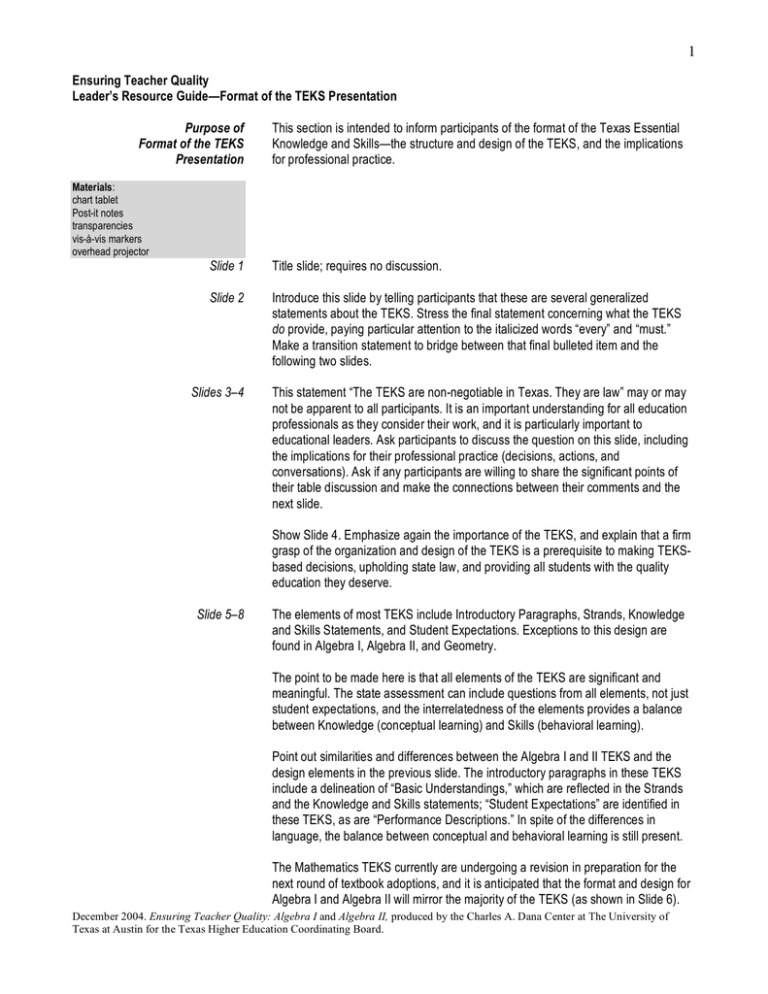1
advertisement

1 Ensuring Teacher Quality Leader’s Resource Guide—Format of the TEKS Presentation Purpose of Format of the TEKS Presentation This section is intended to inform participants of the format of the Texas Essential Knowledge and Skills—the structure and design of the TEKS, and the implications for professional practice. Materials: chart tablet Post-it notes transparencies vis-à-vis markers overhead projector Slide 1 Title slide; requires no discussion. Slide 2 Introduce this slide by telling participants that these are several generalized statements about the TEKS. Stress the final statement concerning what the TEKS do provide, paying particular attention to the italicized words “every” and “must.” Make a transition statement to bridge between that final bulleted item and the following two slides. Slides 3–4 This statement “The TEKS are non-negotiable in Texas. They are law” may or may not be apparent to all participants. It is an important understanding for all education professionals as they consider their work, and it is particularly important to educational leaders. Ask participants to discuss the question on this slide, including the implications for their professional practice (decisions, actions, and conversations). Ask if any participants are willing to share the significant points of their table discussion and make the connections between their comments and the next slide. Show Slide 4. Emphasize again the importance of the TEKS, and explain that a firm grasp of the organization and design of the TEKS is a prerequisite to making TEKSbased decisions, upholding state law, and providing all students with the quality education they deserve. Slide 5–8 The elements of most TEKS include Introductory Paragraphs, Strands, Knowledge and Skills Statements, and Student Expectations. Exceptions to this design are found in Algebra I, Algebra II, and Geometry. The point to be made here is that all elements of the TEKS are significant and meaningful. The state assessment can include questions from all elements, not just student expectations, and the interrelatedness of the elements provides a balance between Knowledge (conceptual learning) and Skills (behavioral learning). Point out similarities and differences between the Algebra I and II TEKS and the design elements in the previous slide. The introductory paragraphs in these TEKS include a delineation of “Basic Understandings,” which are reflected in the Strands and the Knowledge and Skills statements; “Student Expectations” are identified in these TEKS, as are “Performance Descriptions.” In spite of the differences in language, the balance between conceptual and behavioral learning is still present. The Mathematics TEKS currently are undergoing a revision in preparation for the next round of textbook adoptions, and it is anticipated that the format and design for Algebra I and Algebra II will mirror the majority of the TEKS (as shown in Slide 6). December 2004. Ensuring Teacher Quality: Algebra I and Algebra II, produced by the Charles A. Dana Center at The University of Texas at Austin for the Texas Higher Education Coordinating Board. V. Course Follow-up, A. Leader’s Resource Guide, 3. Materials for a Format of the TEKS presentation Slide 6 is simply a visual representation of the design elements of the TEKS. Point out to participants that this is for illustration only; the graphic is not meant to suggest that each TEKS consists of only two strands, four knowledge and skills statements, and eight student expectations. Slide 7 Use Slide 7 to identify the elements of this particular piece of the TEKS. The identifier A.5 shows this is an Algebra I TEKS statement. The boldface statement in the left column is the Strand, and it is followed by the Knowledge and Skill statement. In the right column, three Performance Descriptions are listed, specifying both conceptual learning and behavioral learning. Slide 8 The chart on this slide reflects the mathematic strands from Kindergarten to 8th grade, as well as Algebra I and Algebra II. Facilitate a discussion among participants about how the knowledge and skills statements and student expectations change through the grades to reflect developmentally appropriate mathematical learning. Point out the continuity between basic understandings in Algebra I and Algebra II and the specific references to those courses in the Precalculus introductory paragraphs. December 2004. Ensuring Teacher Quality: Algebra I and Algebra II, produced by the Charles A. Dana Center at The University of Texas at Austin for the Texas Higher Education Coordinating Board. 2




